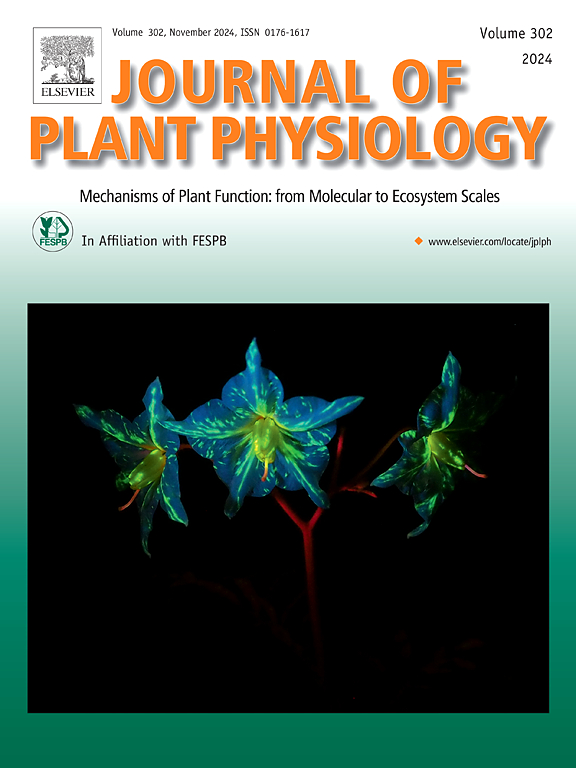Nitrate sensing and response in Plants: From calcium signaling to phytohormone regulation
IF 4.1
3区 生物学
Q1 PLANT SCIENCES
引用次数: 0
Abstract
Plants need to acquire sufficient nitrogen (N) from the soil for their growth and development. Nitrate (NO3−) is the major source of N for plants in aerobic soils. In addition to its role as a nutrient, nitrate also acts as a signaling molecule to reprogram plant metabolism and trigger changes in plant architecture. With the development of genomics technologies and genetic tools, breakthroughs in the understanding of the nitrate signaling network have been made over the past years. In this review, we will discuss the mechanisms of nitrate sensing and its transcriptional response throughout the plant, with an emphasis on the effect of nitrate-elicited calcium signal on the primary nitrate response (PNR). Recent studies have not only identified a second nitrate sensor, NLP7, but also identified calcium-dependent kinases (CPKs) as a molecular link between membrane-localized nitrate receptor NRT1.1 (CHL1/NPF6.3) and NLP transcription factors, which bridges the nitrate gap. We also discuss the latest progress on the interaction between nitrate signal and hormonal pathways for local and systematical developmental responses in the model plant Arabidopsis thaliana roots. A holistic view of how all the identified signals crosstalk to orchestrate the thousands of N responses is the key for the sustainable development of agriculture.
植物对硝酸盐的感知和响应:从钙信号到植物激素调节
植物的生长发育需要从土壤中获取足够的氮。硝态氮(NO3−)是好氧土壤中植物氮的主要来源。除了作为一种营养物质,硝酸盐还作为一种信号分子,重新编程植物代谢并引发植物结构的变化。近年来,随着基因组学技术和遗传工具的发展,对硝酸盐信号网络的认识取得了突破性进展。在这篇综述中,我们将讨论整个植物的硝酸盐感知及其转录响应机制,重点讨论硝酸盐诱导的钙信号对初级硝酸盐响应(PNR)的影响。最近的研究不仅发现了第二个硝酸盐传感器NLP7,而且还发现钙依赖性激酶(CPKs)是膜定位硝酸盐受体NRT1.1 (CHL1/NPF6.3)和NLP转录因子之间的分子连接,从而弥补了硝酸盐的缺口。本文还讨论了模式植物拟南芥根系中硝酸盐信号与激素通路相互作用在局部和系统发育反应中的最新进展。全面了解所有已识别的信号如何相互作用以协调数千个N响应是农业可持续发展的关键。
本文章由计算机程序翻译,如有差异,请以英文原文为准。
求助全文
约1分钟内获得全文
求助全文
来源期刊

Journal of plant physiology
生物-植物科学
CiteScore
7.20
自引率
4.70%
发文量
196
审稿时长
32 days
期刊介绍:
The Journal of Plant Physiology is a broad-spectrum journal that welcomes high-quality submissions in all major areas of plant physiology, including plant biochemistry, functional biotechnology, computational and synthetic plant biology, growth and development, photosynthesis and respiration, transport and translocation, plant-microbe interactions, biotic and abiotic stress. Studies are welcome at all levels of integration ranging from molecules and cells to organisms and their environments and are expected to use state-of-the-art methodologies. Pure gene expression studies are not within the focus of our journal. To be considered for publication, papers must significantly contribute to the mechanistic understanding of physiological processes, and not be merely descriptive, or confirmatory of previous results. We encourage the submission of papers that explore the physiology of non-model as well as accepted model species and those that bridge basic and applied research. For instance, studies on agricultural plants that show new physiological mechanisms to improve agricultural efficiency are welcome. Studies performed under uncontrolled situations (e.g. field conditions) not providing mechanistic insight will not be considered for publication.
The Journal of Plant Physiology publishes several types of articles: Original Research Articles, Reviews, Perspectives Articles, and Short Communications. Reviews and Perspectives will be solicited by the Editors; unsolicited reviews are also welcome but only from authors with a strong track record in the field of the review. Original research papers comprise the majority of published contributions.
 求助内容:
求助内容: 应助结果提醒方式:
应助结果提醒方式:


